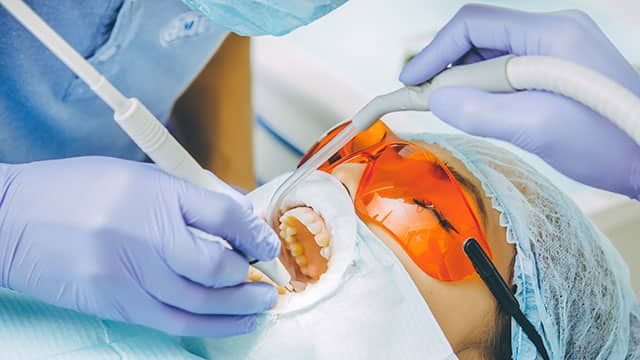With the increasing demand for teeth whitening, faster, safer, and more effective technologies are now available. There are various options for achieving a brighter smile and addressing yellow teeth, such as professional in-office teeth whitening treatments and at-home whitening kits. Keep reading to learn more about these options and determine which type of teeth whitening treatment can help you remove tooth discolouration.
What is Teeth Whitening?
Teeth whitening is the process of removing stains, black spots, or discolouration from your teeth to enhance the whiteness of your teeth. Both surface stains as well as deeper, intrinsic stains within the enamel can be lightened through teeth-whitening products and treatments. It is essential to understand that whitening is not a one-time event and may require periodic dental treatments or the consistent use of whitening products.
Types of Teeth Whitening Treatments
Various teeth whitening treatments and methods are available for you to choose from. The right whitening product or procedure for you depends on several factors, such as the extent of your stains, your overall oral health, the amount of time you have, the expected duration of results, and potential side effects.
Professional Teeth Whitening Treatments
Professional teeth whitening treatments can provide quick whitening effects personalised to your needs. Your dentist will prescribe a tooth whitening treatment specific to your teeth, which may involve creating an imprint of your teeth for a custom whitening tray or an in-office whitening treatment. Depending on your dentist's recommendation, an in-office whitening treatment may take multiple visits, each lasting between 30 to 90 minutes. However, light- or laser-activated tooth bleaching, often completed in a single visit, may also be utilised.
Home Teeth Whitening Kits
Teeth whitening toothpaste, whitening strips, whitening gels, trays, and pens are common over-the-counter whitening products that one might encounter while looking for at-home teeth whitening. These kits are often more affordable and convenient to use as a teeth whitening method when compared to professional treatments. While they may not deliver results as fast as those from a dental professional, they can still contribute to brightening teeth. Among them, teeth whitening toothpaste is a good choice for brightening teeth and keeping up with regular oral care.
These toothpastes often contain whitening agents that follow a process similar to bleaching. They also include advanced technologies like active oxygen for deep stain removal, as seen in products like Visible White O2, which starts whitening your teeth in 3 days. This revolutionary whitening formula works by releasing millions of active oxygen bubbles that penetrate the tooth enamel and lighten the stains on the teeth, working not only on the tooth surface but from the inside out.
Whitening Teeth at Home Using Colgate Visible White Booster Gel
Many people want to achieve whiter teeth quickly. Colgate's revolutionary product, the Visible White Booster Gel, is designed to help you attain instant whitening of teeth in the comfort of your home. With daily use, it provides you with visibly whiter teeth in a matter of two weeks. It is an effective solution to consider if you want to brighten your smile for an upcoming big event.
Colgate Visible White Booster Gel is an innovative product formulated with active oxygen that lightens the stains deep set in the tooth enamel and reveals visibly whiter teeth in 14 days. It delivers the maximum whitening results when used twice daily after brushing. It requires a simple three-step application process—squeeze, apply, and leave-on, which makes it easier to whiten teeth within a short time period.
Teeth Whitening Procedure
Understanding how teeth whitening works is essential when it comes to achieving the desired results effectively and safely. In-office professional teeth whitening treatment typically involves several steps that ensure both efficacy and safety. These include:
The dental professional begins by assessing the current shade of the teeth using a tooth shade chart. They may also discuss the potential whitening outcome with the patient.
To prepare the teeth for whitening, the dental professional uses a pumice tool to polish the teeth and remove any remaining plaque.
Different tools are used to keep the mouth open to prevent the whitening agent from contacting sensitive areas like the gums, cheeks, or tongue.
Additionally, a protective gel is applied to the gums to shield them from the bleaching agent.
The bleaching agent, concentrated hydrogen peroxide, is then applied to the teeth and left for up to an hour. If necessary, additional coats of the whitening agent may be applied.
In some cases, the dentist may use a special light on the teeth to enhance the whitening effect.
Within one hour, the teeth may appear 8 to 10 shades brighter.
After the whitening process, the mouth is rinsed, and a protective solution may be applied to reduce potential tooth sensitivity.
Benefits of Teeth Whitening Treatment
Teeth whitening provides benefits beyond providing a brighter smile; it also plays a role in promoting overall oral health and improving dental hygiene in various ways:
Enhanced appearance: Whiter teeth can enhance the overall appearance and smile of an individual.
Improved oral health: Whitening teeth treatment often involves thorough cleaning, which can remove stains from the surface, plaque, and tartar, promoting healthier gums and teeth.
Long-lasting result: The duration of whitening results varies from person to person, however, tooth whitening treatment can provide long-lasting results by maintaining good oral hygiene.
Safety Considerations and Risks
While teeth whitening can enhance tooth whiteness, it is crucial to be aware of the potential safety considerations and side effects associated with this process. These may include:
Chemical burns: Gel bleaching, particularly with high concentrations of oxidising agents, can lead to chemical burns if the bleaching products come into contact with unprotected tissues.
Tooth sensitivity: Over Bleaching, also known as “over-white teeth,” can result in sensitive teeth, making them prone to discomfort, especially when exposed to hot or cold temperatures.
Rebound effect: After initial whitening, there is a risk of the teeth losing their bleached effect and darkening again, known as the rebound effect, which may become apparent within 30 days.
Discussing these potential risks with your dental professional before undergoing any teeth whitening procedure is crucial for reducing the likelihood of experiencing adverse effects. Additionally, to maintain the teeth-whitening effect, it is often recommended to avoid the consumption of acidic or pigmented beverages such as coffee, tea, fizzy drinks, and red wine.
Teeth whitening procedures, ranging from professional in-office teeth whitening processes to at-home kits, offer options for achieving a brighter smile. However, it is essential to consider factors such as the extent of tooth staining, the individual’s oral health status, and potential side effects associated with teeth whitening treatment. Regular dental checkups, proper flossing, and maintaining your natural teeth health are integral to oral care, complementing the teeth whitening process. Consulting with a dental professional before taking on any instant teeth whitening treatment is essential for a personalised approach that considers both cosmetic goals and oral health considerations.
Frequently Asked Questions
1. Do teeth whitening treatments hurt?
Teeth whitening treatments generally do not hurt when performed correctly. However, some people may experience temporary tooth sensitivity or gum irritation during or after the procedure. If you have concerns about pain or sensitivity, it is best to consult with your dental professional before undergoing any tooth whitening treatment.
2. Who is not suitable for teeth whitening?
Not everyone can go for teeth whitening. This includes people who have dental restorations or crowns, and they may want to talk to their dentist before considering whitening.
3. Is teeth whitening treatment safe?
Yes, teeth whitening treatment is generally safe when handled with the same care as any medical procedure. You may take the necessary advice from your dental professional, adhere to the instructions, and take precautions for side effects.
4. Are there any side effects of teeth whitening?
Tooth sensitivity is a prevalent side effect that may arise either during or after treatment. Misapplication or excessive use of teeth whitening products can also result in gum irritation.
This article is intended to promote understanding of and knowledge about general oral health topics. It is not intended to be a substitute for professional advice, diagnosis or treatment. Always seek the advice of your dentist or other qualified healthcare provider with any questions you may have regarding a medical condition or treatment.
ORAL HEALTH QUIZ
What's behind your smile?
Take our Oral Health assessment to get the most from your oral care routine
ORAL HEALTH QUIZ
What's behind your smile?
Take our Oral Health assessment to get the most from your oral care routine













